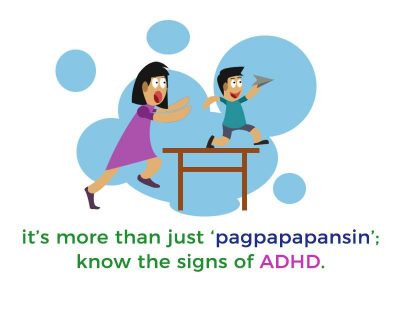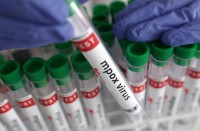
EAGLE NEWS— Don’t mind him, “kulang lang sa pansin ‘yan!”
“Kulang sa pansin” is a Filipino slang we often hear when a person describes a very naughty child who acts in a way different from how others act.
But if your child displays unusual hyperactivity and impulsivity, better not dismiss it. It might be more than just “pagpapapansin.”
This could be a sign of Attention-Deficit Hyperactivity Disorder or ADHD.
What is ADHD?
ADHD or Attention Deficit Hyperactivity Disorder (ADHD) is a highly genetic, brain-based syndrome that has to do with the regulation of a particular set of brain functions and related behaviors.
These brain operations are collectively referred to as “executive functioning skills” and include important functions such as attention, concentration, memory, motivation, and effort, learning from mistakes, impulsivity, hyperactivity, organization, and social skills.
According to the National Council of Disability Affairs (NCDA), around 4 to 5 percent of children worldwide are affected by the neurobiological disorder. ADHD is the most commonly diagnosed behavioral disorder in children, says The New York Times.
ADHD can persist through adulthood, though. In fact, “one third to one-half of children with ADHD continues to have symptoms of inattention or hyperactivity-impulsivity as adults.”
Children with ADHD oftentimes manifest symptoms of hyperactivity and inattention. They have difficulties paying attention, acting without thinking and being overly active.
Suspecting that your child has ADHD? Check these signs!
Those with inattention…
- Overlook or miss details, make careless mistakes in schoolwork, at work, or during other activities.
- Have problems sustaining attention in tasks or play, including conversations, lectures, or lengthy reading.
- Don’t seem to listen when spoken to directly.
- Do not follow through on instructions and fail to finish schoolwork, chores, or duties in the workplace or start tasks but quickly lose focus and get easily sidetracked.
- Have problems organizing tasks and activities. They may have difficulty keeping materials and belongings in order, have messy work and poor time management, and fail to meet deadlines.
- Avoid or dislike tasks that require sustained mental effort, such as schoolwork or homework, or for teens and older adults, preparing reports, completing forms or reviewing lengthy papers.
- Lose things necessary for tasks or activities, such as school supplies, pencils, books, tools, wallets, keys, paperwork, eyeglasses, and cell phones.
- Are easily distracted by unrelated thoughts or stimuli.
- Are forgetful in daily activities.
Those with hyperactivity-impulsivity may often…
- Fidget and squirm in their seats
- Leave their seats in situations when staying seated is expected, such as in the classroom or in the office
- Run or dash around or climb in situations where it is inappropriate or, in teens and adults, often feel restless
- Be unable to play or engage in hobbies quietly
- Be constantly in motion or “on the go,” or act as if “driven by a motor”
- Talk nonstop
- Blurt out an answer before a question has been completed, finish other people’s sentences, or speak without waiting for a turn in conversation
- Have trouble waiting for his or her turn
- Interrupt or intrude on others, for example in conversations, games, or activities.
Contrary to common perception, ADHD is NOT caused by poor parenting; falls or head injuries; traumatic life events; digital distractions; video games and television; lack of physical activity; food additives; food allergies; or excess sugar.
It is caused by chemical, structural and connectivity differences in the brain, mostly as a result of genetics (inherited).
Is there a way to prevent this disorder? As of now, there is no cure for ADHD, but there are treatments available to help reduce symptoms and improve functioning. These include medication, psychotherapy, education or training, or a combination of these.
For many people with ADHD, medications reduce hyperactivity and impulsivity and improve their ability to focus, work, and learn. Medication may also improve their physical coordination.
The most common type of medication used for treating ADHD is called a “stimulant.” This increases the brain chemicals dopamine and norepinephrine, which both play an essential role in the thinking and attention process of an individual.
Parents must be cautious in giving their children stimulants because of the possible side effects associated with every use. Stimulants may cause increased blood pressure and heart rate; seizures; heart failure; glaucoma, liver or kidney disease; and/or anxiety disorder.
Just like depression, ADHD shouldn’t be taken for granted. Parents must be aware of their child’s behavior in school and in the home. Prevention is always better than cure.
Here are some helpful tips outlined by the National Institute of Mental Health for teachers and parents dealing with kids and adults with ADHD.
Help kids with ADHD to stay organized by:
- Keeping a routine and a schedule. Keep the same routine every day, from wake-up time to bedtime. Include times for homework, outdoor play, and indoor activities. Keep the schedule on the refrigerator or on a bulletin board in the kitchen. Write changes on the schedule as far in advance as possible.
- Organizing everyday items. Have a place for everything, and keep everything in its place. This includes clothing, backpacks, and toys.
- Using homework and notebook organizers. Use organizers for school material and supplies. Stress to your child the importance of writing down assignments and bringing home the necessary books.
- Being clear and consistent. Children with ADHD need consistent rules they can understand and follow.
- Giving praise or rewards when rules are followed. Children with ADHD often receive and expect criticism. Look for good behavior, and praise it.
On the other hand, adults with ADHD may seek a professional counselor or therapist in organizing his life. This can be done by keeping routines; making lists for different tasks and activities; using a calendar for scheduling events; using reminder notes; assigning a special place for keys, bills, and paperwork; and breaking down large tasks into more manageable, smaller steps so that completing each part of the task provides a sense of accomplishment.
Jodi Bustos, Eagle News Service








